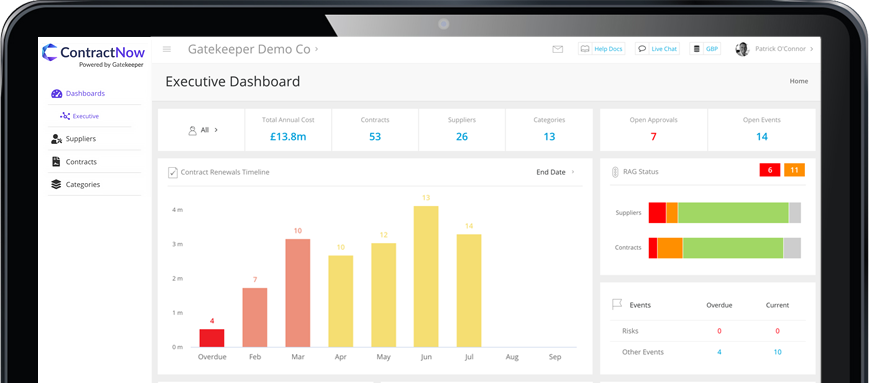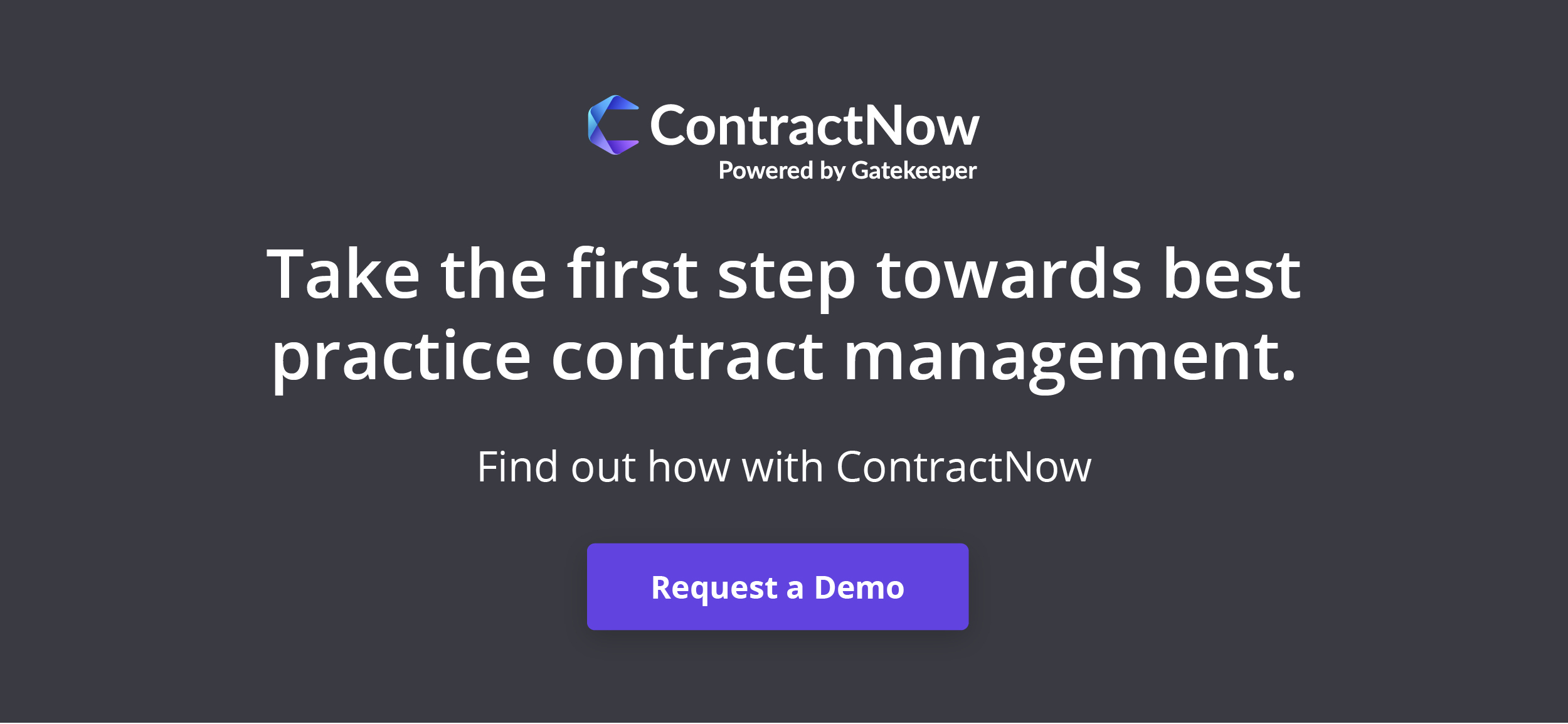In a world that has been so heavily disrupted, most businesses are facing stronger headwinds than ever before. COVID-19 has changed the way we complete tasks, how we communicate and how we maintain relationships with third-parties.
But one thing hasn’t changed: contracts are still running along in the background – with their terms and obligations still needing to be fulfilled.
It could be argued that if your business doesn’t already have a contract management software in place, now is the most important time to take action.
Understanding what obligations are in place, being alerted to potential contract risk and being able to track key dates such as those relating to renewals will help businesses to maintain levels of control and stability.
However, making a business case for new technology can be a challenge under any circumstances.
Whether you’re looking for simple contract management software for the future or you’re looking to demonstrate how a solution could improve your overall processes, this article will equip you with the tactics you need to put forward a compelling case to your stakeholders.
Be prepared to talk your stakeholders’ language
It’s much easier for those handling contracts every day to understand and experience the impact of poor contract management processes. These experiences can include:
- Missing renewals resulting in increased or unwanted costs
- Losing hard-to-replace relationships with suppliers
- Hours spent looking for contracts and key data
- Inability to verify who signed a contract and when
Introducing a technology that can automate processes, send alerts about upcoming events or even extract information quickly and easily may seem like a given for individuals familiar with these situations, but the same can’t always be said for stakeholders."
That’s because some of the most important benefits of contract management software aren’t easy to articulate in a calculable and measurable way.
Unless you’re willing to investigate your current approach to contract lifecycle management, embrace the surprises this may turn up and be honest with your stakeholders about current pitfalls, your business case could already be on its last legs.
So what steps do you need to take to build the most compelling case?
Create a summary of all existing contracts
It’s important to create a comprehensive summary of all the contracts across your organisation, rather than delivering just a snapshot to your stakeholders.
By taking a deep-dive into your organisation, you should be able to summarise essential contract metadata such as:
- Total number of contracts and their value
- The obligations of each party throughout the contracts
- How many contracts are coming up for renewal
- Top vendors by contract value
- Any additional benefits that should be realised through existing agreements.
This may seem like a time-consuming effort but it’s a great opportunity to understand the real scope of all the contracts in your business. Centralising your agreements in a contract repository will save your business a lot of time.
It is also likely to turn up new information about contract statuses, new insights into the way your people and processes work and expose hidden areas of risk.
On the flip side, this deep-dive will help you to demonstrate all the different areas where a contract management solution can make a positive impact on the business – especially when it comes to having all this information kept in a single, visible and accessible place if another business-wide review needs to take place."
When creating your summary you may find that you need to include additional information, especially if you’re asking for additional funding or extra resources.
Remember, the more information and examples you have, the easier it will be to achieve buy-in from your stakeholders.
 ContractNow's Executive Dashboard
ContractNow's Executive Dashboard
Outline the estimated return on investment
Money talks and that’s the real language you need to adopt. When putting your business case together for a contract management solution you should present the combined cost savings and additional benefits realisation to determine the ROI.
Although contract management software involves a level of investment often dependent on the amount of contracts being handled, the features required and any add-ons needed, there should be a natural return based on cost savings.
These savings can be realised through a number of methods including:
- Identification of duplicate or delinquent spend on suppliers
- Hours saved through automation, thereby eliminating manual workload
- Visibility of renewal dates, so early action can be taken to find cheaper alternatives and unwanted goods or services can be cancelled without fail
- Auditable compliance with all necessary legislation and regulation, mitigating the risk of fines, prosecution or reputational damage
- Ability to send contracts for electronic signatures, cutting down print and post costs and speeding up the time to signature and value
Don’t forget that cost savings don’t always have to be hard. Your stakeholders will be equally interested in softer savings made through efficiency gains.
Look closely at the way your processes can be streamlined through the use of technology and how it can empower your people to focus on their areas of expertise.
Benefit realisation is also an important element to investigate. More often than not, contracts aren’t always assessed to ensure the negotiated benefits are being delivered."
Not only can this create a financial sink, but it also means that businesses aren’t getting the real value from their agreements.
One way to present benefit realisations to your stakeholders is to audit 2-5 of your existing, high value contracts. Analyse whether or not the agreed benefits are being delivered at the expected rate and assess how your suppliers are generally performing.
Your business may be similar to those who fail to realise even 50% of negotiated savings over a contract’s period and if so, this activity will be a real point of persuasion for your stakeholders.
To calculate projected ROI, combine your estimated savings figure and benefits realisation. Divide this total by the cost estimate of the contract management software and you’ll be able to demonstrate the value it will have to your business.
Your minimum benchmark should be 3:1 to ensure viability.
Identify potential risk mitigation
Although difficult to quantify, unidentified contract risk can cost your business in multiple ways.
Without a contract management solution in place, identifying, monitoring and being alerted to these risks can be a real challenge, but this needs to be communicated in a way that appeals to your stakeholders’ interests.
There are a variety of risk types you should explore including:
- Operational risk: relationships that rely too heavily on one person, terms and conditions not being met, potential gaps in supply chain if a supplier is lost
- Reputational risk: social, environmental or even political adversity that could change the perception of the business
- Regulatory risk: lack of compliance, failure to protect data or any potential breaches.
You also need to look at all the angles involved. Who can currently access contracts, how are they being stored, who can communicate with suppliers without it being known, how much risk do your suppliers themselves carry and does your business have any processes in place to address such issues?
In some instances, especially in highly regulated industries such as healthcare, having a contract management solution can prove highly favourable as having an centralised repository with automation capabilities makes compliance so much easier.
Your stakeholders won’t just want to know how a contract management solution will add to the business’s bottom line, they’ll want to know how it can protect it too."
This is the prime time to outline how the solution can help the business as a whole to mitigate potential risks.
Through improved collaboration, shared intelligence, controlled user settings, automated alerts and full audit trails, your stakeholders can rest easy that business continuity becomes an easily achieved priority when the right software is in place.
Conclusion
When putting together a business case for contract management software, it’s crucial to consider the all-round potential impact of the proposed contract management solution.
To persuade your stakeholders and bring them around to your way of thinking, it’s vital that you can talk their language and appeal to their interests and concerns about the business.
To recap, your business case should include:
- A full summary of the business’s contract portfolio, including information such as value, total and key dates
- How much investment is required and how returns will be realised
- An overview of hard and soft cost savings and how they can be achieved
- An investigation into existing business risks and how the solution in question will mitigate these issues.
Ultimately, your business case should reinforce that the benefits of a contract management solution extend far beyond the individuals who use it. The right software can improve processes across the entire business, encourage deeper relationships with suppliers and help the business to unlock competitive advantage.
Once your business case is improved, book a demo to see ContractNow in action.




